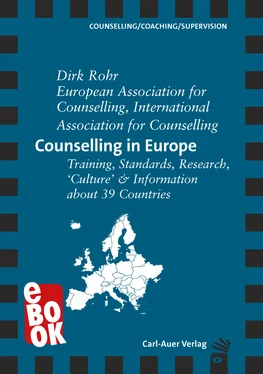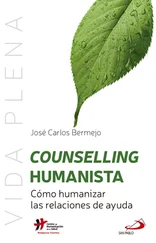Personal Commitment
From the start of training and post-qualification, Counsellors will:
• Sign their agreement to maintain the relevant codes of ethics and Practice;
• Hold professional liability insurance;
• Have ongoing counselling supervision or peer supervision as required;
• Ensure continuing personal and professional development.
2.8 Counselling Training: Recommended Programme
Each programme will have its methodology according to its philosophical and theoretical base. The following are guidelines for the establishment of a counsellor-training programme.
Length of training
This programme is a minimum period of 3 years and a maximum of 6 years, class contact of at least 450 hours.
Core Theory – to include
• Clear understanding of a core theoretical model of counselling
• Theories of personality
• Theories of change or client movement
• Models of human development
• Understanding of psychological dysfunction
• Understanding of ethics and professional Practice
• The history of counselling and a study of at least two other counselling approaches
• Study of cultural differences and awareness processes
Counselling Process
The programme will enable the trainee to:
• Establish a counselling relationship;
• Work within a clear theoretical frame;
• Heighten awareness of interpersonal dynamics;
• Develop their ability to understand and work with communication;
• Facilitate the client’s understanding and self-awareness of the issue presented;
• Explore their ongoing professional development by review and evaluation;
• Become aware of and address personal and professional limitations and problems.
Counselling Practice
Training programmes must ensure that trainee counsellors pursue their supervised Practice in an appropriate environment. Usually, be in a formalised and contracted counselling arrangement. Training programmes must ensure that counselling supervision providers are experienced, accredited practitioners in the field and meet the EAC Accrediting Organisation guidelines in their own country.
In addition to these arrangements, clear contracts need to establish:
• Supervision arrangements;
• Ethics and Professional Practice;
• Administrative arrangements;
• Any financial arrangements;
• Liaison and referral to other professionals and services.
2.9 Counselling Supervision
Supervised Practice
Formal and contracted Supervision of counselling practice as defined below. EAC recognises that in some countries, practitioners will find it difficult at the moment to have Supervision from an accredited or professional counsellor. Supervision from a qualified professional in an allied field with an understanding of counselling as defined by EAC.
Definition of Counselling Supervision
• Counselling supervision is a contracted, professional relationship between two or more individuals engaged with counselling activities, which leads to reflection on the counselling situation and its structure;
• Supervision provides emotional support, containment and clear boundaries for the counsellor and the counselling work;
• Supervision encompasses an element of learning that includes elucidation of codes of ethics and Practice;
• Supervision responsibly monitors the working process between counsellor and client;
• The supervisory relationship and process of Supervision are congruent with the developmental needs of the supervisee;
• Supervisors are responsible for monitoring their ethical boundaries and abilities.
Description of Counselling Supervision
Counselling supervision enhances the counsellor’s effectiveness in responding to the needs of the client. Towards this purpose, counselling supervision assists those involved in the counselling profession in:
• Becoming increasingly aware of their responses to their counselling work;
• Deepening their professional knowledge;
• Continuously developing their counselling and professional skills;
• Managing their caseload;
• Evaluating their professional Practice.
• Managing their self-care and the prevention of burnout and continuing support through personal development/therapy.
The supervisor offers a climate where the supervisee can feel understood, supported, and challenged and instructed and assisted in their counselling work. The supervisor’s responsibility is to provide conditions that will help the supervisee consider their experiences as reflection, elucidation, and generating sources of knowledge.
Counselling supervision takes place both during the training programme and after completion of the programme. An independent supervisor of his own choice then supervises the counsellor. However, Supervision is evaluated along with the programme.
Models of Supervision
Adopted during the interim five-year period:
• One-to-one (supervisor-counsellor);
• Group supervision with counselling supervisor;
• Combination of the above modes of Supervision;
• Peer supervision could be acceptable for accredited practitioners with five year’s post-accreditation experience. Subject to the requirements of the EAC or the guidelines of individual modalities.
Group Supervision equivalent to one-to-one Supervision.
The same person shouldn’t undertake supervisory and managerial responsibilities. If this cannot be avoided, then the tasks and roles need to be clearly defined and contracted.
Peer group support with clear aims and boundaries can enhance good counselling practice. However, this does not replace Supervision.
2.10 Procedure for the Award of the European Certificate of Counsellor Accreditation (ECCac)
The Accreditation procedures will be monitored and developed by the Professional Training Standards and Accreditation Committee, PTSAC.
Relationship between the EAC Organisation and the Professional Training Standards and Accreditation Committee (PTSAC)
• The PTSAC will examine whether the training standards, accreditation and reaccreditation procedures of the Organisation meet EAC criteria.
• The PTSAC recognises that some Organisations have well-established procedures whilst others are in the early stages of development. Well-established Organisations that have comparable standards of training and accreditation should follow the methods below.
• The EAC Executive recognises that some Organisations are in the early stages of development.
• In these cases, the PTSAC will provide consultation to help Organisations meet the EAC standards of counsellor accreditation. Pro-forma has been designed to guide Organisations in the task.
EAC Accrediting Organisations Route to Accreditation with EAC
• Each EAC Accrediting Organisation will provide the PTSAC with copies of their standards and procedures for counsellor accreditation, codes of ethics, complaints procedures and the Pro-forma for application to the EAC Accrediting Organisations for accreditation with EAC.
• The criteria and procedures are in place and agreed upon by EAC for accreditation through the EAC and cannot be changed. The EAC Accrediting Organisation will be able to recommend candidates for the award of the European Certificate of Counsellor Accreditation.
Individual Accreditation Procedures
• Candidates apply to the EAC for the application form.
• The EAC sends the application form to the candidate to complete.
• The candidate sends the completed application form to the EAC.
• The PTSAC, in collaboration with the EAC Executive, will develop a system that will ascertain that the form’s information is accurate and correct.
Читать дальше












